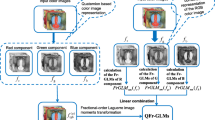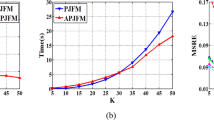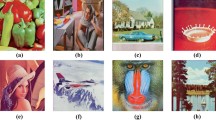Abstract
Pseudo-Jacobi–Fourier moments (PJFMs) are a set of orthogonal moments which have been successfully applied in the fields of image processing and pattern recognition. In this paper, we present a new set of quaternion fractional-order orthogonal moments for color images, named accurate quaternion fractional-order pseudo-Jacobi–Fourier moments (AQFPJFMs). We initially propose a fast and accurate algorithm for the PJFMs computation of an image using new recursive approach and polar pixel tiling scheme. Then, we define a new set of orthogonal moments, named accurate fractional-order pseudo-Jacobi–Fourier moments, which is characterized by the generic nature and time–frequency analysis capability. We finally extend the gray-level fractional-order PJFMs to color images and present the quaternion fractional-order pseudo-Jacobi–Fourier moments. In addition, we develop a new color image representation for enhancing simultaneously the discriminability and robustness, called mixed low-order moments feature. We conduct extensive experiments to evaluate the performance of the proposed AQFPJFMs, in which the encouraging results demonstrate the efficacy and superiority of the proposed scheme.























Similar content being viewed by others
Abbreviations
- AFPJFMs:
-
Accurate fractional-order pseudo-Jacobi–Fourier moments
- APJFMs:
-
Accurate fractional-order pseudo-Jacobi–Fourier moments
- AQFPJFMs:
-
Accurate quaternion fractional-order pseudo-Jacobi–Fourier moments
- AR:
-
Accuracy rate
- BER:
-
Bit error rate
- CHFMs:
-
Chebyshev–Fourier moments
- FCMs:
-
Fractional-order Chebyshev moments
- FJFMs:
-
Fractional-order Jacobi–Fourier moments
- FOFMMs:
-
Fractional-order orthogonal Fourier–Mellin moments
- FPHFMs:
-
Fractional-order polar harmonic Fourier moments
- FPHT:
-
Fractional-order polar harmonic transforms
- FPR:
-
False positive ratio
- FQEMs:
-
Fractional-order quaternion exponential moments
- FQZMs:
-
Fractional-order orthogonal quaternion Zernike moments
- JFMs:
-
Jacobi–Fourier moments
- LFMs:
-
Legendre–Fourier moments
- MLMF:
-
Mixed low-order moments feature
- MSRE:
-
Mean square reconstruction error
- OFMMs:
-
Orthogonal Fourier–Mellin moments
- OMs:
-
Orthogonal moments
- PJFMs:
-
Pseudo-Jacobi–Fourier moments
- PSNR:
-
Peak signal-to-noise ratio
- PZMs:
-
Pseudo-Zernike moments
- QRFCMs:
-
Quaternion radial fractional Charlier moments
- RST:
-
Rotation, scaling, translation
- ZMs:
-
Zernike moments
- ZOA:
-
Zero-order approximation
References
Hu MK (1962) Visual pattern recognition by moment invariants. IRE Trans Inf Theory 2(8):179–187
Teague MR (1980) Image-analysis via the general-theory of moments. J Opt Soc Am 69(8):920–930
Pawlak M (2014) Over 50 years of image moments and moment invariants. Gate Comput Sci Res 73(2):91–110
Teh CH, Chin RT (1988) On image analysis by the method of moments. IEEE Trans Pattern Anal Mach Intell 10(4):556–561
Sheng YL, Shen LX (1994) Orthogonal Fourier–Mellin moments for invariant pattern recognition. J Opt Soc Am 11(6):1748–1757
Ping ZL, Wu RG, Sheng YL (2002) Image description with Chebyshev–Fourier moments. J Opt Soc Am 19(9):1748–1754
Khotanzad A, Hong YH (1990) Invariant image recognition by Zernike moments. IEEE Trans Pattern Anal Mach Intell 12(5):489–497
Ping Z, Ren H, Jian Z et al (2007) Generic orthogonal moments: Jacobi–Fourier moments for invariant image description. Pattern Recogn 40(4):1245–1254
Bailey RR, Srinath MD (1996) Orthogonal moment features for use with parametric and non-parametric classifiers. IEEE Trans Pattern Anal Mach Intell 18(4):389–399
Amu G, Hasi S, Yang X et al (2004) Image analysis by pseudo-Jacobi (p = 4, q = 3)-Fourier moments. Appl Opt 43(10):2093–2101
Camacho C, Báez-Rojas JJ, Toxqui-Quitl C, Padilla-Vivanco A (2014) Color image reconstruction using quaternion Legendre–Fourier moments in polar pixels. In: 2014 IEEE international conference on mechatronics, electronics and automotive engineering (ICMEAE), Cuernavaca, pp 3–8
Amu G, Hasi S, Ai AZ (2015) Research progress of moment invariant image analysis. J Inner Mongolina Agric Univ 26(4):146–150
Qi S, Zhang Y, Wang C et al (2023) A survey of orthogonal moments for image representation: theory, implementation, and evaluation. ACM Comput Surv 55(1):1–35. https://doi.org/10.1145/3479428
Liao SX, Pawlak M (1998) On the accuracy of Zernike moments for image analysis. IEEE Trans Pattern Anal Mach Intell 20:1358–1364
Wee CY, Paramesran R (2007) On the computational aspects of Zernike moments. Image Vis Comput 25(6):967–980
Biswas R, Biswas S (2012) Polar Zernike moments and rotational invariance. Opt Eng 51(8):1–9
Mukundan R, Ramakrishnan KR (1995) Fast computation of Legendre and Zernike moments. Pattern Recogn 28(9):1433–1442
Papakostas GA, Boutalis YS, Karras DA, Mertzios BG (2007) Fast numerically stable computation of orthogonal Fourier–Mellin moments. IET Comput Vis 1(1):11–16
Hosny KM, Shouman MA, Abdel Salam HM (2011) Fast computation of orthogonal Fourier–Mellin moments in polar coordinates. J Real-Time Image Process 6(2):73–80
Walia E, Singh C, Goyal A (2012) On the fast computation of orthogonal Fourier–Mellin moments with improved numerical stability. J Real-Time Image Process 7(4):247–256
Xin Y, Pawlak M, Liao S (2012) Accurate computation of Zernike moments in polar coordinates. IEEE Trans Image Process 6(7):996–1004
Camacho-Bello C, Padilla-Vivanco A, Toxqui-Quitl C et al (2016) Reconstruction of color biomedical images by means of quaternion generic Jacobi–Fourier moments in the framework of polar pixels. J Med Imaging 3(1):014004
Bhrawy A, Zaky M (2016) A fractional-order Jacobi Tau method for a class of time-fractional PDEs with variable coefficients. Math Methods Appl Sci 39(7):1765–1779
Vargas-Vargas H, Camacho-Bello C, Rivera-López JS et al (2021) Some aspects of fractional-order circular moments for image analysis. Pattern Recogn Lett 149:99–108
Su X, Tao R, Kang X (2019) Analysis and comparison of discrete fractional Fourier transforms. Signal Process 160(7):284–298
Kazem S, Abbasbandy S, Kumar S (2013) Fractional-order Legendre functions for solving fractional-order differential equations. Appl Math Model 37(7):5498–5510
Zhang H, Li Z, Liu Y (2016) Fractional orthogonal Fourier–Mellin moments for pattern recognition. In: 2016 Chinese conference on pattern recognition (CCPR). Springer, Singapore, pp 766–778
Benouini R, Batioua I, Zenkouar K, Zahi A, Najah S, Qjidaa H (2019) Fractional-order orthogonal Chebyshev moments and moment invariants for image representation and pattern recognition. Pattern Recogn 86:332–343
Yang H, Qi S, Tian J et al (2021) Robust and discriminative image representation: fractional-order Jacobi–Fourier moments. Pattern Recogn 115:107898
Hosny KM, Darwish MM, Aboelenen T (2020) Novel fractional-order polar harmonic transforms for gray-scale and color image analysis. J Frankl Inst 357(4):2533–2560
Wang C, Gao H, Yang M et al (2021) Invariant image representation using novel fractional-order polar harmonic Fourier moments. Sensors 21(4):1544
Chen B, Yu M, Su Q, Shim HJ, Shi YQ (2018) Fractional quaternion Zernike moments for robust color image copy-move forgery detection. IEEE Access 6:56637–56646
Wang C, Hao Q, Ma B et al (2021) Fractional-order quaternion exponential moments for color images. Appl Math Comput 400:126061
Yamni M, Karmouni H, Sayyouri M et al (2021) Robust zero-watermarking scheme based on novel quaternion radial fractional Charlier moments. Multimed Tools Appl 80(14):21679–21708
Upneja R, Singh C (2015) Fast computation of Jacobi–Fourier moments for invariant image recognition. Pattern Recogn 48(5):1836–1843
Sáez JL (2017) Comments on “fast computation of Jacobi–Fourier moments for invariant image recognition.” Pattern Recogn 67:16–22
Singh C, Upneja R (2012) Accurate computation of orthogonal Fourier Mellin moments. J Math Imaging Vis 44(3):411–431
Singh C, Walia E, Upneja R (2013) Accurate calculation of Zernike moments. Inf Sci 233:255–275
Karakasis EG, Papakostas GA, Koulouriotis DE, Tourassis VD (2013) A unified methodology for computing accurate quaternion color moments and moment invariants. IEEE Trans Image Process 23(2):596–611
Camacho-Bello C (2014) High-precision and fast computation of Jacobi–Fourier moments for image description. J Opt Soc Am 31(1):124–134
Hamilton WR (1866) Elements of quaternions. Longmans, Green, & Company, London
Camacho-Bello C, Padilla-Vivanco A, Toxqui-Quitl C et al (2016) Reconstruction of color biomedical images by means of quaternion generic Jacobi–Fourier moments in the framework of polar pixels. J Med Imaging 3(1):57–66
Petitcolas APF (2000) Watermarking schemes evaluation. IEEE Signal Process Mag 17(5):58–64
Wen Q, Sun TF, Wang SX (2003) Concept and application of zero-watermark. Acta Electron Sin 31:214–216
Shao Z, Shang Y, Zeng R, Shu H, Coatrieux G, Wu J (2016) Robust watermarking scheme for color image based on quaternion-type moment invariants and visual cryptography. Signal Process Image Commun 48:12–21
The Whole Brain Atlas. http://www.med.harvard.edu/AANLIB/home.html
Yang H, Qi S, Niu P, Wang X (2020) Color image zero-watermarking based on fast quaternion generic polar complex exponential transform. Signal Process Image Commun 82:115747
Xia ZQ, Wang XY, Zhou W, Li R, Wang C, Zhang C (2019) Color medical image lossless watermarking using chaotic system and accurate quaternion Polar Harmonic transforms. Signal Process 157:108–118
Wang CP, Wang XY, Chen XJ, Zhang C (2017) Robust zero-watermarking algorithm based on polar complex exponential transform and logistic mapping. Multimed Tools Appl 76(24):26355–26376
Wang CP, Wang XY, Xia ZQ, Zhang C, Chen XJ (2016) Geometrically resilient color image zero-watermarking algorithm based on quaternion exponent moments. J Vis Commun Image Represent 41:247–259
Chang CC, Lin PY (2008) Adaptive watermark mechanism for rightful ownership protection. J Syst Softw 81(7):1118–1129
The USC-SIPI image database. http://sipi.usc.edu/database/
Xia Z, Wang X, Han B et al (2021) Color image triple zero-watermarking using decimal-order polar harmonic transforms and chaotic system. Signal Process 180:0165–1684
Kang X, Zhao F, Chen Y et al (2020) Combining polar harmonic transforms and 2D compound chaotic map for distinguishable and robust color image zero-watermarking algorithm. J Vis Commun Image Represent 70:1047–3203
Liu J, Li J, Ma J et al (2019) A robust multi-watermarking algorithm for medical images based on DTCWT-DCT and Henon map. Appl Sci 9(4):700–722
Coil-100. http://www.cs.columbia.edu/CAVE/software/softlib/coil-100.php
Wang XY, Wang L, Tian JL et al (2021) Color image zero-watermarking using accurate quaternion generalized orthogonal Fourier–Mellin moments. J Math Imaging Vis 63:708–734
Acknowledgements
This work was supported partially by the National Natural Science Foundation of China (Nos. 61472171 & 61701212), Natural Science Foundation of Liaoning Province (No. 2019-ZD-0468), and Scientific Research Project of Liaoning Provincial Education Department (No. LJKZ0985).
Author information
Authors and Affiliations
Corresponding authors
Ethics declarations
Conflict of interest
The authors declare that they have no conflict of interest.
Ethical standards
All procedures performed in studies involving human participants were in accordance with the ethical standards of the institutional and/or national research committee and with the 1964 Helsinki Declaration and its later amendments or comparable ethical standards.
Informed consent
Informed consent was obtained from all individual participants included in the study.
Additional information
Publisher's Note
Springer Nature remains neutral with regard to jurisdictional claims in published maps and institutional affiliations.
Appendices
Appendices
1.1 Appendix A
By Eq. (4), the weighting function is:\(w(r) = (1 - r) \cdot r^{2}\).
Here replace the independent variable \(r\) of the radial basis function with the new variable \(r = r^{\alpha } ,r \in [0,1]\), and the new weight function can be obtained as:
We define a new radial basis functions:
The proof is complete.
1.2 Appendix B
Taking the conjugate of \(H_{nm\alpha }^{L}\), there are:
Therefore, \(H_{nm\alpha }^{L} = - (H_{( - n)( - m)\alpha }^{R} )^{ * }\).
1.3 Appendix C
Rights and permissions
About this article
Cite this article
Wang, X., Zhang, Y., Tian, J. et al. Accurate quaternion fractional-order pseudo-Jacobi–Fourier moments. Pattern Anal Applic 25, 731–755 (2022). https://doi.org/10.1007/s10044-022-01071-6
Received:
Accepted:
Published:
Issue Date:
DOI: https://doi.org/10.1007/s10044-022-01071-6




